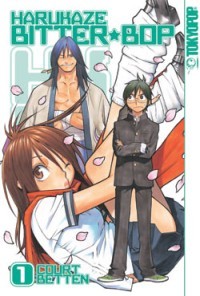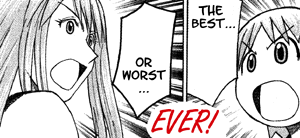RIGHT TURN ONLY!!
New Year's Revolutions
by Carlo Santos,

A winter storm came blustering in this weekend.
I feel kind of bad for everyone who went to Anime Los Angeles, which seems to have the worst weather luck when it comes to scheduling a winter con. Oh, and speaking of cons ... and con drama ...
D.GRAY-MAN

Vol. 7
(by Katsura Hoshino, Viz Media, $8.99)
FROM THE BACK COVER:
"Set in a fictional 19th century England, D.Gray-man is the story of Allen Walker, a 15-year-old boy who roams the earth in search of Innocence. Washed away to unknown parts of the world after The Great Flood, Innocence is the mysterious substance used to create weapons that obliterate demons known as akuma.
Allen has disappeared. Lavi and Lenalee rush to find him, only to wind up confronting a horde of akuma pursuing Allen's golem Timcanpy. After dealing with this they are ordered to continue their mission without Allen, his place to be taken by a new Exorcist—Miranda Lotto. Allen, meanwhile, wakes up inside the Asian Branch of the Black Ministory to the sobering reality that he has lost his Innocence!"
EVIDENCE FOR:
Wouldn't it be awesome if "losing one's Innocence" had a greater metaphorical meaning to it? That doesn't actually happen in this volume of D.Gray-man, but it does make for a fantastic string of chapters where Allen walks through a world of mysterious visions, wakes up with his magical arm lopped off, and then fights to reclaim his Innocence powers. This is the stuff that great epic drama is made of—bringing your hero to the brink of death and then making him claw his way back! It's also a chance to go all-out with artistic concepts: the otherworld that Allen sees while he's in his coma, the imposing architecture of the Black Ministry's Chinese branch, and some thrilling action scenes as Allen tries to revive his Innocence. But what about his other friends? Don't worry, they've moved on to their own set of escapades: Miranda Lotto's power of "time recovery" is a visual wonder to behold, and an attack from an oceanic akuma puts their little sea cruise into all sorts of high-flying peril. Now this is what adventure is made of.
EVIDENCE AGAINST:
If this is what adventure is made of, it's kind of boring. Sure, action scenes are fun, but when you're just throwing them all on top of each other with no changes of mood or pace in between, then it becomes a whole lot of high-tension noise. It's like Allen is always in danger, and his team is always fighting akuma, with never a chance for the plot to recap or recover. And because it's always in action mode, we never get a chance to get to know the characters better: after all this time, secondaries like Lavi and Lenalee are still just names and faces, somehow interconnected but never deep enough for anyone to care. This action overload also turns the artwork into some kind of overdrawn mess: speedlines upon speedlines, physical and spiritual attacks every which way, until you can't even tell who the good guys and the bad guys are anymore. There may be some clever artistic designs on display here, but when it becomes a dull exercise in "draw as much whoosh as possible," that's when adventure becomes boring.
FINAL VERDICT:
I'd really like to get into D.Gray-man someday. But clearly, today is not that day, as it delivers just another round of mindless C-level spirit-fighting action.
E'S

Vol. 4
(by Satol Yuiga, Broccoli, $9.99)
FROM THE BACK COVER:
"The search for the Sacrament of Calvarias becomes more complicated when Yuuki and Asuka are attacked by rebel psychics and must join forces with Maria to survive. Meanwhile, Kai finds himself in a world where psychics battle in a blood sport for both the glory of their religion and the greed of the wealthy. Back in Ashurum, Shen-long suspects there is something wrong with his sister, Shin-lu, and to make matters worse, there are three strange new recruits on their team!"
EVIDENCE FOR:
If there is one thing that makes this volume of E's worth it, it's the arrival of super-psychic Maxim Feller, who basically goes around making mincemeat of anyone who stands within 10 feet of him. He's a powerful, ruthless character with an attitude to match his ability, and the mere presence of him is enough to take this conflict in a new direction. But that's not the only plot thread taking a sharp turn—Kai (remember him? The main character?) sees and discovers things too shocking to behold, and that changes his entire attitude towards the Church that's been harboring him, as well as his relationship with the little kid he's been hanging out with. Amidst all these turns and surprises, we still manage to get a healthy dose of action, especially in the first few chapters where Maxim demonstrates his level of power. Stylish lines, dynamic attacks, and pages that practically explode with psychic energy—this fantasy-future world is as exciting as they come.
EVIDENCE AGAINST:
Too many lines, my dear Yuiga, too many lines. The action may be beautifully energetic, but often loses control of itself with the special effects—like when Yuuki comes bursting in through the window to save Asuka, which is somehow crammed into half-a-page of whoosh and swoosh that's supposed to be Yuuki kicking a bad guy. And why is almost every psychic attack some form of fire or explosion? It also doesn't help that the artwork is much too gray, with tones laid over everything just for the sake of laying down tones. But the real problem with E's right now lies much deeper than the visuals: the threads of plot are really starting to come apart, as if they were three disconnected stories rather than one proper series. There's Yuuki, Asuka and Maria on the run; Kai's dealings with the Church; Shen-long and Shin-lu trying to get along with their new teammates—and they are all coasting right past each other like ships in the night. Will this story ever pull itself together, and will it ever start making sense?
FINAL VERDICT:
Great action and excitement, but the art gets sloppy, and the story even more incoherent. This overwrought psychic-battling mess gets a C-.
HARUKAZE BITTER BOP

Vol. 1
(by Court Betten, Tokyopop, $9.99)
FROM THE BACK COVER:
"Chiyoharu used to be the leader of the troublemakers, until one day an innocent prank results in a major fire at the school. When his three cohorts take the blame and are expelled, Chiyoharu tries to go on with his mundane life, beating himself up with guilt. Then he meets the mysterious muscle-man Souza of the North Wind and a ditzy self-proclaimed detective who is trying to solve the mystery behind Souza's amnesia... It's nonstop comedy and action from there!"
EVIDENCE FOR:
Here's a great way to start a series: introduce three very strange but very memorable characters, mix them up together, and see what happens next. Having an outspoken protagonist like Chiyoharu would probably be enough for most stories, but with a forgetful strongman and a nutcase girl detective tagging along, this one's a goldmine of instant comedy. The arrival of Chiyoharu's school buddies about halfway through just adds to the humor potential—it seems like everyone's got some kind of personality defect, and it's just funny watching them get into all sorts of bizarre situations. And believe me, there is no shortage of bizarre situations here: in this volume alone, Chiyoharu gets himself handcuffed, tries to save his hot homeroom teacher from a gangster, and gets himself hypnotized. And that's not even mentioning what happens to the other characters. The clean lines and fast-paced energy of the artwork make this a fun read—especially with the many wacky facial expressions—and despite the many characters, the variety of designs makes it really easy to tell them apart. Always a good sign.
EVIDENCE AGAINST:
There is always the danger, in any action-comedy, that the story's just going to devolve into some kind of aimless farting around in search of a cheap laugh. Unfortunately, it looks like Harukaze Bitter Bop is already headed that way, with its disjointed chapters that seem more focused on "crazy people hanging out" rather than figuring out what's up with Souza. The later chapters do hint at a deeper storyline lurking underneath—and we can all hope that (say it with me now) it gets better later on—but this first volume might throw a lot of people off with its sheer incoherence. That incoherence is what makes the story feel pretty shallow right now, with a lot of interesting and funny characters but none worth caring about. The energy also wears off too quickly with all those "talking head" scenes in between the action—sure, the dialogue's funny, but if there isn't anything going on visually, then it might as well be prose.
FINAL VERDICT:
Definitely very funny and energetic, but the general nonsense and lack of story direction make this a B-.
SAND CHRONICLES

Vol. 1
(by Hinako Ashihara, Viz Media, $8.99)
FROM THE BACK COVER:
"After her parents get divorced, Ann Uekusa and her mother move from Tokyo to rural Shimane. Accustomed to the anonymity of city living, Ann can't get used to the almost overbearing kindness of the people in her mother's hometown. But when personal tragedy strikes, Ann discovers how much she needs that kindness."
EVIDENCE FOR:
Sand Chronicles makes one very daring move in its first volume: after a hundred pages, the story jumps forward a year and a half, going straight from Ann's personal tragedy at Age 12 to the stirrings of first love at 14. It's a dramatic change in a series full of dramatic changes, unafraid to show the true challenges of growing up. The first half is all about Ann and her mother's troubled relationship, with a shocking, tearjerking climax that most other series can't even hope for after 15 volumes. Things aren't quite as serious after the time jump, but it's still sweet in its own way—sure, it's a moment you've all seen in shoujo manga before, but it's never been done with such grace and subtlety. And perhaps that's why this series is so special: the storytelling really flows like grains of sand, capturing the gentle rhythms of life instead of exaggerating it into a string of clichés. That gracefulness comes out in the artwork too, with the deeply expressive faces and those heart-stopping moments where the imagery tells the story without a single word at all. Fumbling through adolescence has never been easy, but this is one series that truly understands those feelings.
EVIDENCE AGAINST:
It's hard to see this as an accurate portrayal of adolescence when everything is so formalized and idealized. The perfectly orchestrated childhood tragedy, the arrival of the dream guy, the school activity where everything suddenly changes forever—come on, there is no one in the three-dimensional world whose teenage life worked out like this, and if you think it did, that's just selective memory. So while Sand Chronicles delivers plenty of powerful emotion, it also teeters dangerously on the brink between drama and melodrama. The long chapters also make for a number of rambly filler scenes, especially in the middle of the summer camp episode where it threatens to turn into another brainless love comedy. Oh, and someone get Hinako Ashihara a new set of screentones before she hurts a hand trying to cram the pentagon pattern onto everything. Really, there are many other ways to make a plain background interesting.
FINAL VERDICT:
It might be overdoing it with the drama, but it just feels so good to read. And to look at. This genuine, heartfelt portrayal of youth definitely earns its A-.
V.B. ROSE

Vol. 1
(by Banri Hidaka, Tokyopop, $9.99)
FROM THE BACK COVER:
"Ageha is shocked and heartbroken when her beloved older sister announces that she's pregnant and getting married to (in Ageha's mind) the most boring man alive! But all hope is not lost as Ageha stumbles onto the job of a lifetime—helping to make her sister's wedding dress. Velvet Blue Rose is a super-exclusive bridal design shop run by Yukari and Mitsuya, two super-hot guys. When Mitsuya, the pattern-maker at V.B. Rose, hurts his hand, will Ageha jump in to save her sister's happy dream of marriage, in spite of her own reservations?"
EVIDENCE FOR:
The bridal industry may be a strange, specialized little world, but V.B. Rose makes it look like a lot of fun. Drawn with a sure-handed sense of line—from the elegant backgrounds and attractive characters to eye-grabbing comedy moments—this series is sure to entertain with its classic let's-all-get-ready-for-the-wedding scenario. Ageha's initial disapproval and lack of tact make her a striking, memorable character from the get-go, as well as establishing the up-and-down relationship she has with her big sister. It only takes one volume, though, to see Ageha's personality start to change, thanks to the help of two hot guys and some part-time sewing work. Fashionistas will love the hardcore textile talk going on here, and a number of full-page bridal gown scenes prove Banri Hidaka's sense of style. But behind it all, the quest for a great wedding dress is really just a metaphor for Ageha's growth as a person: can she finish the task and do her sister proud? With a great central character and a lively story, it's definitely worth finding out the answer.
EVIDENCE AGAINST:
Limiting one's self to a specialized little world may not be the best idea for plot expansion. Ageha's entire motive right now is to help prepare for her sister's wedding—and when that's finished, what then? The way things are paced, the big day will probably be over by the end of Volume 2. The limited subject matter may also have trouble finding its audience; the whole "being a bride is the most beautiful thing in the world" state of mind hangs heavy over the entire series, and if you don't buy into that philosophy, then sympathizing with the characters is a lost cause. Of course, some characters aren't even developed enough to sympathize with in the first place—that would be the token hot guys who run the bridal shop and give Ageha work to do. I never thought I'd say this, but we could do with more romantic tension between the girl-next-door and the unattainable bishounen, if only to make them more interesting.
FINAL VERDICT:
The storytelling flows smoothly and it's a whole lot of fun—so despite the limited subject matter, this comedy-drama piece is still worth a B.

DRAMACON

Vol. 3
(by Svetlana Chmakova, Tokyopop, $9.99)
FROM THE BACK COVER:
"People say the best way to cure a crush on someone is get to know them. Will Matt and Christie's love survive their first 'date?'
Now college students, Christie and Bethany are back to pimp their comic at the Yattacon, and Bethany is glowing with pride because her designs are on every T-shirt at the con! But while Christie is thrilled to be back hanging out with the wacky crowd from Firebird Studios, one thing after another keeps her from getting together with Matt. Could it be that these two are just not destined to be together?"
EVIDENCE FOR:
The first one was cute and innocent, the second was troubled and pedantic, and the third ... well, here's Dramacon fully matured at last, a perfectly brewed formula of comedy, drama and romance. While most readers will want to see if Matt and Christie finally get together (three guesses and the first two don't count), the real star of this volume is sidekick Bethany, who gets into all sorts of trouble when her mother finds out just what an "anime convention" is and what Bethany plans to do as a "manga artist." It's a brilliant piece of family drama, poignant in ways that no schoolyard romance could ever match. Still, Matt and Christie do have their moments—gorgeously drawn love scenes, razor-sharp sarcastic dialogue, and somewhere in the background, lots of good old fandom mockery. After all, what would Dramacon be without riffing on cosplayers, or glompers, or yaoi? Visual gags and in-jokes abound, as well as a parade of delightful characters, and a masterful sense of layout (the accident scene beats just about everything, ever) makes this one flow from start to finish. Now all we can do is hope and pray that someday there'll be a Dramacon 2 series.
EVIDENCE AGAINST:
Ah, it wouldn't be a teen romance if there weren't a host of teen romance clichés. Matt's whole "male tsundere" routine got kind of tired about midway through Volume 2, which is why his relationship issues with Christie feel kind of flat this time—it's like they're going through the same song-and-dance we've seen twice before. Honestly, it's the Bethany subplot that saves this volume, but even that one has its faults: the incident with her mother is just too perfectly timed, leading to a resolution that plays out like an after school special. Really, what's with these "message" storylines? I'm sure kids can figure out the importance of following your dreams without having it lobbed at them like a brick to the head. And then there's the overuse of chibi style characters in the artwork, which ends up being like a crutch for cuteness and comedy—oh, we ran out of good jokes, here's a squishy face and some googly eyes. Dramacon may be awesome, but it's still not perfect.
FINAL VERDICT:
It's not Genshiken, but it may be the closest thing North America will ever have. Great characters, sharp writing and a moving story make this an insta-buy for anyone.

Sometimes, good stuff comes out of nowhere—or the underground! Here's one of the oddest and Best Manga I've Ever Read:
SECRET COMICS JAPAN

(edited by Chikao Shiratori, Viz, $19.95)
For many, the attraction to Japanese pop culture comes from its rampant weirdness and wackiness, and nowhere is that more evident than in Secret Comics Japan. This anthology truly puts the "alternative" in alternative comics—an inversion and perversion of everything you thought you knew about manga. Anti-establishment satire, sexual deviancy, and grotesque horror—perhaps the only thing missing is some kind of shoelace-gazing autobiographical piece, but American comics have already cornered the market on that, so never mind.
To get a taste of this book's aesthetic sensibilities, go no further than the first story: "The Life of Momongo" is a parade of sex jokes and grotesquerie, with Junko Mizuno's unforgettable guro-kawaii (disgusting-cute) art to top it off. Once that's been burned into your brain, there are plenty of other styles to explore, from the pencil scratchings of "Mutant Hanako" (a super-offensive postwar parody) to the Junji Ito-esque self-mutilation horror in "Punctures." In between are some more tender stories, like the surreal family drama of "Swing Shell" and a couple of Kiriko Nananan shorts, but if there's one common thread through this collection, it's that the characters, the situations, and the style are the furthest thing from any of today's mega-popular hit series. And that's what makes it fascinating.
But wait, I've saved the best part for last (and so does the book): Usamaru Furuya's "Palepoli," in which he bends the very fabric of the four-panel gag. If M.C. Escher had been a manga-ka, it might have turned out like this: self-referential loops, meta-gags, abstract experiments, and a healthy dose of black humor. Just look at the "Fiend of Rejections" sequence, where a mysterious spectre keeps on messing with the literal page that the manga is drawn on. Is this really the same guy who did The Music of Marie? You bet, and it's only in Secret Comics Japan that Furuya—along with many other talented artists—can truly let loose with the imagination.
discuss this in the forum (17 posts) |